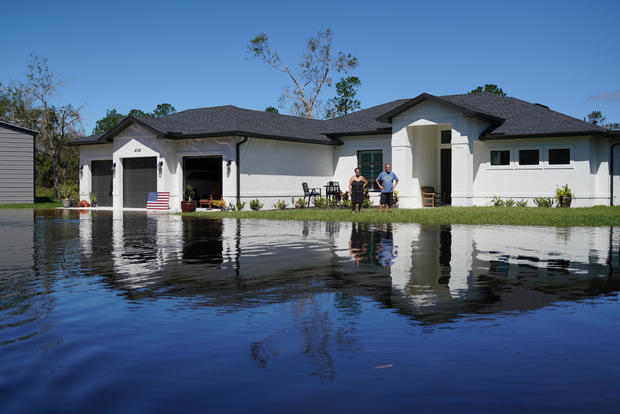- Artists transform hurricane aftermath into hoop-inspired masterpieces at Charlotte exhibit
- NC's cost for Hurricane Helene damage is nearly $60 billion, state says
- State to develop drone program to better respond to disasters like Helene, Florence
- South Carolina residents face deadline to get storm debris out to the curb after Hurricane Helene
- SCDOT to pick up Hurricane Helene debris for a final day in South Carolina
Rescuers continue search for Hurricane Ian survivors in Florida

Rescuers searched for survivors among the ruins of Florida’s flooded homes from Hurricane Ian while authorities in South Carolina began assessing damage from its strike there as the remnants of one of the strongest and costliest hurricanes to ever hit the U.S. continued to push north.
The powerful storm terrorized millions of people for most of the week, battering western Cuba before raking across Florida from the warm waters of the Gulf of Mexico to the Atlantic Ocean, where it mustered enough strength for a final assault on South Carolina.
At midday on Saturday, the official statewide death toll in Florida stood at 24. But after contacting local sheriffs’ offices on Saturday, CBS News found that the number of deaths attributed directly or indirectly to the hurricane could be as high as 70.
As of Saturday afternoon, nearly 1.2 million homes and businesses remained without power in Florida, and hundreds of thousands of outages were reported across the Carolinas and Virginia.
At a Saturday morning press conference, FEMA and U.S. Coast Guard officials said about 4,000 people have been rescued in Florida by local, state and federal authorities, with a vast majority of those coming from the barrier islands. Some 10,000 people are still in shelters, according to the Red Cross, and authorities have not yet determined what kind of temporary housing will be set up for those who lost their homes.
At least 145 hospitals and medical facilities in Florida were impacted by Hurricane Ian. Of those, 10 emergency departments were fully evacuated. The U.S. Army Corps of Engineers continues to conduct damage assessments.
“There are impacts to the hospital system,” FEMA assistant administrator Anne Bink said, adding that FEMA is engaged in “bulk water delivery” to affected medical facilities, particularly in Lee County.
Meanwhile, crews on Saturday were going door to door in Pine Island, Florida, “to get everyone out,” the Matlacha/Pine Island Fire Control District said on social media.
“We have support from multiple agencies and every house and structure will be checked,” they said in a Facebook post. “Please understand that communication systems have been hit severely and it is difficult for first responders to communicate with each other, much less the public. If there are any updates on the status of the island we will push all information through our Facebook, app, and local news.”
“Again, we are here and we are coming,” they added.
In nearby Sanibel Island, the U.S. Coast Guard and U.S. Army Corps of Engineers will soon send barges as a short-term solution for getting equipment and materials to the decimated island.
“That area is going to be out of out of commission for a long time,” said U.S. Coast Guard Rear Admiral Brandon McPherson. “It does not have water. It does not have basic infrastructure. I think some people might have though they could stay there for some time, but after camping out for a night or two, they’re realizing that’s not a viable option.”
In South Carolina, Ian’s center came ashore near Georgetown, a small community along the Winyah Bay about 60 miles north of historic Charleston. The storm washed away parts of four piers along the coast, including two connected to the popular tourist town of Myrtle Beach.
During a Saturday afternoon press conference, Gov. Henry McMaster said the state has cleaning and rebuilding to do, particularly in the northwest corner of the state, where residents saw a lot of water. However, he said overall it was a “good story” for South Carolina — there were no reported storm deaths, no hospitals were damaged, water systems were working, and most residents who lost power already had it back on Saturday morning.
“We are open for business,” the governor said.
In some places, though, new problems continued to arise. A 14-mile stretch of Interstate 75 in Florida was closed late Friday in both directions in the Port Charlotte area because of the massive mount of water swelling the Myakka River.
In the Sarasota suburb of North Point, Florida, residents of the Country Club Ridge subdivision waded through waterlogged streets Friday. John Chihil solemnly towed a canoe and another small boat through the ankle-deep water.
“There’s really not much to feel. It’s an act of God, you know?” he said. “I mean, that’s all you can do is pray and hope for a better day tomorrow.”
Now weakened to a post-tropical cyclone, Ian was expected to move across central North Carolina on Saturday morning then move into Virginia and New York.

